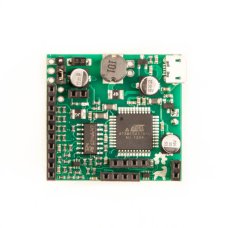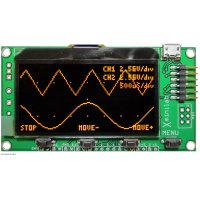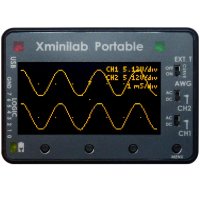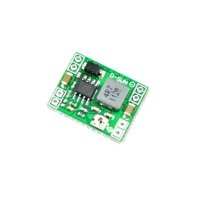A small, portable, USB-connected electronics lab-on-a-board that includes an oscilloscope, waveform generator, power supply, logic analyzer, and multimeter.



|
Oscilloscope |
Sample Rate |
750ksps (shared) |
|
|
Bits per Sample |
8, 12¹ |
|
|
Bandwidth |
~100kHz² |
|
|
Input Voltage Range |
-20V to +20V |
|
|
Input Impedance |
1 MΩ |
|
|
No. of Channels |
2 |
|
|
Coupling |
AC/DC |
|
Arbitrary Waveform Generator |
Waveform types |
Sin, Square, Triangle, Sawtooth, Arbitrary |
|
|
Sample Rate |
1Msps |
|
|
Sample Depth |
64 samples (CH1), 1500 samples (CH2) |
|
|
Output voltage range |
0.15V to 9.5V |
|
|
Bits per Sample |
8 |
|
|
Max. Current |
10mA³ |
|
|
Output Resistance |
50Ω |
|
|
No. of Channels |
2 |
|
Variable Power Supply |
Voltage Range |
4.5V to 15V |
|
|
Max. Power |
~1.5W |
|
|
No. of Outputs |
1 |
|
|
Source Impedance |
Negligible⁴ |
|
|
Ripple Voltage |
+-300mV%@10V 10mA, +-700mV%@10V 100mA |
|
Logic Analyzer |
Sample Rate |
3Msps per channel |
|
|
Supported voltage |
3.3V, 5V, 12V |
|
|
No. of Channels |
2 |
|
Digital Output |
Voltage |
3.3V |
|
|
Source Impedance |
50Ω |
|
Multimeter⁵ |
Input Impedance |
1MΩ |
|
|
Measured Parameters |
V, I, R, C |
|
|
Voltage Range |
-20V to +20V |
|
|
Current Range |
100uA to 10A |
|
|
Resistance Range |
1 ohm to 100k |
|
|
Capacitance Range |
10pf to 1mf |
EspoTek Labrador
- Brand: Crowd Supply
- Product Code: CS-EspoTek-Labrador
- Reward Points: 41
- Availability: Discontinued
-
रo 4,134.00
- Price in reward points: 4134
-
- 3 or more रo 4,101.00
- 7 or more रo 3,670.00
- 17 or more रo 3,465.00
- 34 or more रo 3,377.00
Related Products
XMEGA Xminilab
The Xminilab is a mixed signal oscilloscope with an arbitrary waveform generator in a DIP module. It..
रo 3,999.00 रo 5,850.00
Xminilab Portable
This is the portable version of the Xminilab. The Xminilab Portable is a small mixed signal oscillos..
रo 4,999.00 रo 8,880.00
XM1584 Ultra-Small Size DC-DC Step-Down Power Supply Module
XM1584 Ultra-small size DC-DC step-down 3A adjustable power supply module. Features and Specific..
रo 81.00
ArduCam U6215 Cycle Square Wave Function Generator Module
Arducam U6215 full function signal generator is designed to generate electrical signals in different..
रo 1,265.00 रo 1,445.00






